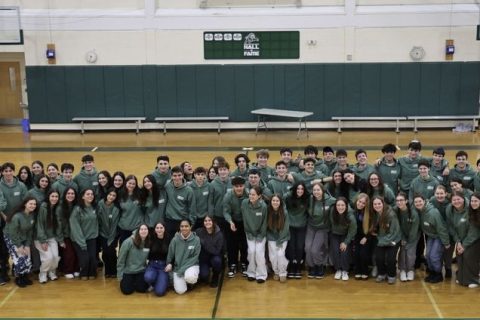
by Rafi Josselson ’25
Rafi Josselson sat down with Transportation Associate Jill Mickol and Security Officer Greg Mines and discussed School Transportation and Logistics. Read this informative Q&A to find out more!
Q: What types of things do you do every day?
Jill Mickol: I am in charge of making sure that every child that takes the bus to school gets here on time and gets picked up.
Greg Mines: I have a lot of responsibilities but the most important thing is ensuring that anyone who enters the property has an appointment. I also make sure that anyone who enters the property is vaccinated and that all vehicles enter safely.
Q: How are students signed up for busing? Can you give us insight into that process?
JM: First I do an RFP ( request for pricing), and I send them to the bus companies that we have used previously. I also look for new ones by looking on the internet and asking some of the districts that I know for recommendations. We get pricing from all of them and make decisions based on the pricing. Leffell subsidizes the cost of the busing, so families don’t pay the full cost. The school pays around 40-50 percent. Once applications open for next year’s transportation, there are new families that have a lot of questions because it is their first time, it is getting everyone all the information they need as fast as possible.
Q: Another form that students fill out is the early dismissal privilege, could you give us some advice on that?
GM: When it comes to early dismissal privileges, students should always make sure to have their pass to exit the premises and be accountable.
Q: How does the school determine the size of the vehicle for each bus route?
JM: It all depends on the number of kids that are going to school from that location. When every kid registers for the buses I create spreadsheets, so when they register I look at how many there are and I determine the size of the vehicle.
Q: When students enter the school they pass through a gate, could you tell us more about that?
GM: Here is a cool thing about the gate, we get grants from Homeland Security in order to operate the gate. The gate is very important to have because it slows down the vehicles that are entering, this keeps everyone safe.
Q: How do you communicate with the bus drivers about a snow or COVID-19 day?
JM: I have a group email with bus companies, districts and private busing. The decision is made at 5:30 in the morning. If I know there is a possibility of inclement weather I will start an email, and I can quickly send an email when I wake up at 6:00 a.m. We also use a call list, like the robocalls you or your parents may get. We do this because we do not know if they will get an email, so I have many of the bus districts’ cell numbers.
Q: What do you do on a day-to-day basis when you are not focusing on getting buses in and out?
JM A lot of spreadsheets. In the morning, before any buses arrive we look to see if anyone is registered for the late bus (6:30 p.m.). I also answer parent questions, and I get a lot of them, such as if a child wants a playdate or if a middle schooler could take the high school bus.
GM: When I am not directing bus traffic I am letting in visitors and parents who have appointments, this is again to make sure that our campus is safe so that everyone on campus is accounted for.
Q: What is the most challenging part of your job?
JM: You are all teenagers and you like to socialize because you have been in school all day. So that makes it hard getting everyone on their buses because they want to talk to their friends, and I understand that. We try to get the buses in and out within five to ten minutes, so you guys can get home, we know you all have extracurriculars to attend and homework to get done. I also have to deal with all the one-offs of if a child is taking the bus for the first time or if someone is going home with a friend. I never want to leave a child here, I want every child to get home. Also, some of the high school 4:20 buses come in too early, and the 3:30 buses come in too late, so I need to make sure that the 3:30 buses can come in to get the kids or turn around. I have to know who all the bus drivers are and what all the buses are. I need to make sure that the buses are where they are supposed to be and that they are not moving when kids get on the buses.
GM: The biggest challenge that I face is when vehicles will try to speed. Another challenge is that sometimes when getting on buses, students are not being alert of their surroundings, it’s important that students be observant of their surroundings so that they can get on their buses safely and quickly. I also want to remind students that during recess students should stay in the courtyard, taking walks around the building can be dangerous since I am trying to direct traffic.
Q: What is the most surprising part of your job?
JM: Every day is different. There is always something that you never thought would happen. This year it was that there weren’t enough bus drivers.
GM: The most surprising part of my job is when visitors show up without appointments. Any visitor should have an official appointment with the school, this is to make sure that everyone who is on campus belongs here.
Q: What is the best part of your job?
JM: I love working with the kids. I love getting to know the kids, when you walked in I recognized you because you are sitting out there every day with your friends. Getting to know the kids over the years is wonderful, and at the end of the day looking around and seeing no kids, it’s wonderful because I know that I am sending everyone home safely.
GM: My favorite part of being a security officer is greeting everyone with a smile, and I love talking with students, parents and bus drivers.




